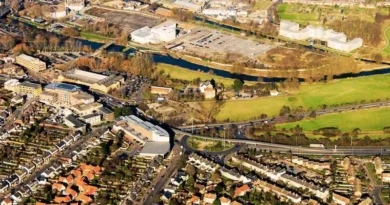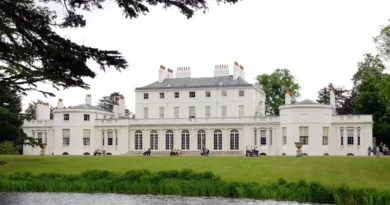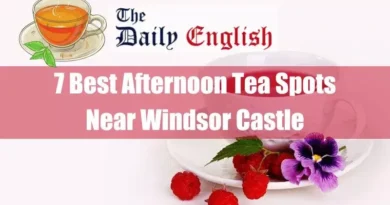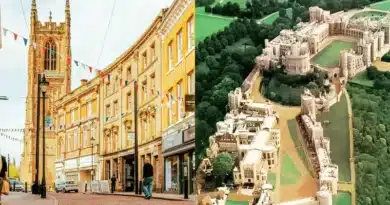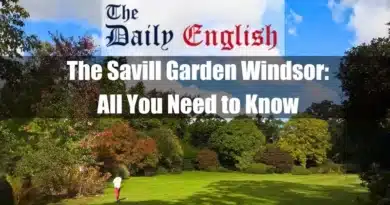What Are The Flags In Windsor Castle
Windsor Castle displays several important flags that mark its royal heritage. The Royal Standard is flown from the castle’s highest flagpole when the monarch is in residence. This large flag is divided into four sections representing England, Scotland and Ireland, and it clearly indicates the presence of the King or Queen. When the sovereign is absent, the Union Flag is raised instead. In addition, ceremonial banners and regimental colours are on display inside the castle during official events and state ceremonies, such as those held in St George’s Chapel. These flags form a central part of Windsor Castle’s long-standing traditions.
Takeaways
| Key Points |
|---|
| At Windsor Castle, the flags displayed externally serve as both visual markers of royal presence and representations of the United Kingdom’s rich heraldic heritage, with the Royal Standard being the most recognisable flag—historically hoisted to signify the monarch’s attendance and distinguished by its striking design of four quadrants bearing England’s three golden lions, Scotland’s red lion, and the Irish harp, while notably excluding Wales due to its distinct symbols and traditions. |
| The flag’s protocol is meticulously observed: it is raised on the highest flagstaff at dawn when the monarch is present, remains at full mast throughout the day, and is never lowered to half-mast even during periods of national mourning, while members of the Royal Family display their own personal standards, defaced with heraldic labels that denote their individual identities. |
| Complementing the Royal Standard is the Union Flag, whose origins date back to the early 17th century, combining the crosses of St George, St Andrew, and St Patrick to symbolise the union of England, Scotland, and Ireland, and which is flown when the monarch is absent, following strict guidelines regarding its correct orientation and daily hoisting and lowering routines. |
| Other external flags and flagstaffs at Windsor Castle, some fashioned in styles reminiscent of maritime traditions that echo Britain’s illustrious naval history, are raised and lowered according to rigorous ceremonial protocols, further reflecting the nation’s storied historical and military legacy. |
| Internally, the castle displays an array of ceremonial banners and regimental colours—from those in the state apartments and grand halls to the heraldic banners of the Knights of the Garter in St George’s Chapel—and features special ceremonial flags such as the rent banner presented during the annual Waterloo Ceremony, as well as temporary flags for state funerals, national celebrations and commemorative occasions, collectively embodying the enduring traditions and multifaceted legacy of British history. |
Introduction
Windsor Castle is far more than a mere royal residence; it is the stage for state ceremonies, national celebrations and historical commemorations that have shaped British history. Since its establishment by William the Conqueror, the castle has witnessed events of profound national importance, many marked by elaborate flag displays. Flags at Windsor Castle denote the monarch’s presence, symbolise military heritage, and act as visual records of pivotal moments in our history.
Flags Displayed on the Exterior of Windsor Castle
The Royal Standard

Historical Background and Significance
The Royal Standard is perhaps the most recognisable flag at Windsor Castle. It has served as the visual marker of the sovereign’s presence for centuries. Historically used on ships and at various royal residences, the flag signifies that the monarch is in attendance. At Windsor Castle, its hoisting is a public declaration of royal occupancy. The standard’s continuous use during state events and official visits underscores the enduring tradition of the monarchy.
Design and Quadrant Symbolism
The design of the Royal Standard is both striking and deeply symbolic. It is divided into four equal quadrants, each representing a facet of the United Kingdom’s heritage. Two quadrants bear the emblem of England—three golden lions passant on a rich red field, symbolising courage, strength and regal authority. One quadrant displays Scotland’s red lion rampant on a gold background, evoking images of martial vigour and noble lineage. The remaining quadrant features the Irish harp on a blue field, a symbol dating back to medieval heraldry and indicative of the historical bond with Ireland.
Notably, Wales is absent from this design, reflecting its status as a principality with distinct symbols and traditions. In Scotland, a variant of the Royal Standard is used, with the arrangement of the quadrants adjusted to accord greater prominence to Scottish heraldry—a nuance that highlights the flexible yet precise approach to representing the different nations within the United Kingdom.
Usage Protocol
The Royal Standard is subject to strict protocols. It is flown on the highest flagstaff of the castle and is raised only when the monarch is present. Once hoisted, it remains at full mast throughout the day—a dignified indicator of royal presence. Unlike other national flags, the Royal Standard is never lowered to half-mast, even during periods of national mourning, as its display embodies the continuity of the monarchy, which is never abeyance. Decisions regarding its display are taken with utmost care by senior officials within the Royal Household, and any deviation from protocol is regarded as a serious breach of royal etiquette.
Variations and Personal Standards
While the Royal Standard represents the sovereign, various members of the Royal Family have their own personal standards derived from the same heraldic principles. These personal flags are “defaced” with heraldic labels—small differences such as three- or five-point marks—to denote personal identity. For instance, the standard the Prince of Wales uses incorporates symbols associated with his title and role, while a Scottish variant reflects local heraldic traditions. Each variation is subject to stringent regulations concerning its use and display, ensuring that the overarching symbolism of the Royal Standard remains undiluted.
The Union Flag (Union Jack)

History and Design
The Union Flag is one of the world’s most recognisable national symbols. Its origins can be traced to the early 17th century when it was created to symbolise the union between England and Scotland. With the inclusion of Ireland in 1801, the flag evolved into its present form—a composite of the crosses of St George, St Andrew and St Patrick. Today, the Union Flag stands as a testament to the political and cultural union of the nations that form the United Kingdom. Its design, though simple in appearance, encapsulates a complex history of conquest, alliance and integration.
Display Protocol
The Union Flag is flown at Windsor Castle when the monarch is not in residence. Positioned on a prominent flagstaff, it serves as the national emblem, representing the unity of the United Kingdom. The flag is hoisted at the start of the day and lowered at the end, and during times of national mourning, it is typically flown at half-mast. Strict guidelines dictate its correct orientation—particularly the placement of the broader white diagonal stripe above the red stripe nearest the flagpole—to ensure that it is not inadvertently displayed upside down.
Design Specifications and Nuances
Longstanding heraldic guidelines determine the Union Flag’s proportions and dimensions. These specifications are adhered to during every display, whether on public buildings, state functions or private properties during official visits by dignitaries. This exacting attention to detail in the flag and protocol reflects the profound respect afforded to this symbol of national unity.
Other External Flags and Flagstaff Features
Flag Hoisting and Lowering Procedures
In addition to the Royal Standard and the Union Flag, Windsor Castle features a range of other flags, each raised and lowered according to strict routines. Typically, all flags are hoisted at dawn and lowered at dusk. During periods of national mourning, while most flags are lowered to half-mast as a mark of respect, the Royal Standard remains at full mast—a practice that underscores the continuity of the monarchy even in times of loss.
Notable Flagstaff Features and Historical Curiosities
The flagstaffs at Windsor Castle are themselves objects of considerable historical interest. Many of these masts are constructed in styles that reflect the castle’s architectural heritage. Some, for instance, bear a design reminiscent of a ship’s spar, hinting at Britain’s rich maritime traditions. Such details, often discussed among historians, add another layer of intrigue to the castle’s exterior and serve as a visual reminder of the multifaceted legacy of British history.
Flags and Banners Displayed Inside Windsor Castle
Ceremonial Banners and Regimental Colours

Presentation of Colours and Their Significance
Inside Windsor Castle, ceremonial banners and regimental colours pay tribute to the nation’s long-standing military traditions. Historically carried into battle to identify units and rally troops, these regimental colours now play a central role in formal ceremonies.
They symbolise the honour, bravery and enduring legacy of the regiments that have served the country. The presentation of new colours is a solemn, meticulously conducted ceremony that underscores the historical continuity of military service and the close bond between the armed forces and the monarchy.
Display in State Apartments and Ceremonial Halls
Ceremonial banners are prominently displayed in the castle’s state apartments and grand halls, where they complement the opulent surroundings and reinforce the venue’s role in hosting official receptions and banquets. Each banner is carefully positioned to both enhance the room’s architectural splendour and pay homage to the military unit it represents. Detailed heritage guides document these displays, ensuring every visitor understands each regimental colour’s historical significance.
Banners in St. George’s Chapel

Heraldic Banners of the Knights of the Garter
St. George’s Chapel, renowned for its Gothic magnificence, is home to an impressive collection of heraldic banners from the Knights of the Garter. Each banner, emblazoned with its respective knight’s unique coat of arms, serves as a vibrant reminder of the chivalric traditions that have defined the Order since its inception.
These banners enhance the chapel’s interior and act as historical documents that record the membership and achievements of one of Britain’s most venerable orders of knighthood.
Installation, Conservation and Maintenance
The installation and preservation of these banners are carried out according to strict heraldic guidelines. Conservators and dedicated staff maintain these delicate artefacts through regular cleaning, careful repairs and controlled storage conditions. Such efforts are supported by the Royal Collection Trust and independent heritage organisations, ensuring that the historical and artistic details of the banners remain intact for future generations.
Special Ceremonial Flags
The Rent Banner and the Waterloo Ceremony
One of the most distinctive traditions at Windsor Castle is the annual Waterloo Ceremony, during which a specially designed rent banner is presented to the monarch. This ceremony originated in the early 19th century when the Duke of Wellington was granted a symbolic, rent-free residence in return for his military triumph at the Battle of Waterloo.
Every year, a luxurious banner—crafted with intricate embroidery and adorned with gold details—is presented as a symbolic payment of rent. Once presented, the banner is displayed prominently within the castle, serving as a visual reminder of Britain’s martial heritage and the enduring legacy of the victorious Duke of Wellington.
Temporary and Special Occasion Flags
In addition to the permanent flags, Windsor Castle employs a range of temporary flags for special events such as state funerals, national celebrations and commemorative occasions. These flags are designed specifically for each event, often incorporating unique colours and motifs that reflect the day’s significance. The temporary flags are either retired or replaced after the event, underscoring their role as transient yet deeply symbolic markers of historical moments.
Protocols and Traditions Involving Windsor Castle Flags
Flag Display Protocols and Hierarchy
A strict hierarchy and detailed protocols govern the display of flags at Windsor Castle. The Royal Standard, representing the sovereign, always precedes all other flags. When the monarch is in residence, it is the sole flag permitted on the highest flagstaff; when absent, the Union Flag is displayed instead. These protocols extend to every aspect of flag handling—from the precise times of hoisting at sunrise and lowering at sunset to the careful orientation required to avoid any disrespect, such as flying the flag upside down.
During periods of national mourning, flags other than the Royal Standard are lowered to half-mast as a sign of respect. These protocols, developed over centuries, reflect the deep-seated reverence for the symbols representing the monarchy and the nation.
Annual Ceremonies and Special Events
The Changing of the Guard
Perhaps the most iconic daily event at Windsor Castle is the Changing of the Guard. This ceremony, which attracts thousands of visitors each year, is a display of military precision and a showcase for the castle’s flag protocols. Depending on the monarch’s presence, either the Royal Standard or the Union Flag is prominently displayed during the ceremony.
Every step of the process, from the inspection of the guards to the handling of the flag, is conducted according to centuries-old traditions, reinforcing the importance of the symbols that represent royal authority.
The Garter Service at St. George’s Chapel

The annual Garter Service at St. George’s Chapel is another major ceremonial event highlighting the castle’s deep-rooted traditions. During the service, the heraldic banners of the Knights of the Garter are unfurled in a visually striking and historically significant display.
This ceremony not only honours the chivalric traditions of the Order of the Garter but also symbolises the enduring relationship between the monarchy and the military. The precise arrangement and careful display of these banners adhere to rigorous heraldic standards, ensuring that every detail reflects the Order’s storied past.
The Waterloo Ceremony and Flag Presentations
The Waterloo Ceremony is a uniquely significant event at Windsor Castle. On the anniversary of the Battle of Waterloo, the annual presentation of the rent banner takes place—a tradition that symbolises the payment of ceremonial rent by the Duke of Wellington to the reigning monarch.
This ritual, steeped in history, involves the careful crafting and presentation of a specially embroidered flag that commemorates the victory over Napoleon. The event serves as both a tribute to military achievement and a poignant reminder of the long-standing ties between the armed forces and the monarchy.
Historical Evolution of Flags at Windsor Castle
Early Flags and Medieval Banners
Windsor Castle’s association with flags dates back to the medieval period when banners served as practical identifiers for noble families and as markers of royal authority on the battlefield. Early flags were relatively simple in design, crafted from available materials and used primarily for identification in battle. As heraldry evolved and became more codified, these banners began to incorporate intricate designs and symbols that reflected the lineage and authority of the ruling monarch.
Development of the Modern Royal Standard
The modern Royal Standard took shape during the Victorian era when heraldic designs were standardised and refined. This era saw the consolidation of symbols representing England, Scotland and Ireland, ensuring each element was rendered precisely and clearly. Successive monarchs have introduced only minor modifications, preserving the core heraldic elements that have come to define the British monarchy.
Today, the modern Royal Standard is recognised not only as a symbol of royal presence but also as a historical artefact that encapsulates centuries of tradition and national pride.
Institutions and Organisations Involved
The Royal Household and the Royal Collection Trust
The management and upkeep of Windsor Castle’s flags are overseen by the Royal Household, which is responsible for the castle’s day-to-day operations. The Royal Collection Trust plays a crucial role in preserving the historical artefacts housed within the castle, including its extensive collection of flags and banners. Together, these institutions ensure that the rich heritage embodied by the castle’s flags is maintained and passed on to future generations.
Specialist Flagmakers and Suppliers
Specialist flagmakers, such as Flying Colours Flagmakers, are commissioned to produce the bespoke flags used during official ceremonies. These expert craftsmen use techniques honed over centuries to ensure that each flag meets the highest quality and historical accuracy standards.
The Role of the Flag Officer at Windsor
A dedicated Flag Officer at Windsor oversees all aspects of flag protocol. This officer ensures that every flag is raised, lowered, and displayed strictly with royal guidelines. In addition, the Flag Officer coordinates with various departments to manage special events, state visits and other occasions where flag displays play a central role.




